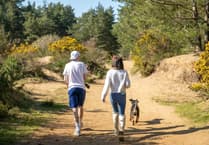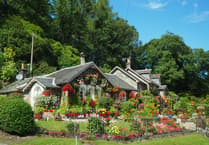Did you know that much of the countryside surrounding us here is a habitat rarer than rainforest?
East Hampshire boasts some of the last remaining large areas of lowland heath in the south of England and is home to some extremely rare reptile, amphibian and bird species.
Much of the heathland around here is in fact so special it’s protected by law and known as the Wealden Heath Phase II Special Protection Area (SPA) designated due to three special heathland bird species which nest on or near to the ground in the summer months: Dartford warbler, European Nightjar and Woodlark.
The Heathlands Reunited SAMM Project (Strategic Access Management and Monitoring) is a partnership of conservation and community organisations led by the South Downs National Park, aiming to monitor, protect and enhance these specially protected heaths around Whitehill & Bordon through events, activities and expert led guided walks by a team of heathland rangers.
Top species to spot right now
It might seem a little quiet on the heaths at the moment, but winter is a great time to start exploring the heaths and connect with nature, so we have put together a list of the top species to watch out for over the next couple of months:
It is small, quick and difficult to spot, so instead, we recommend listening out for one of the year-round residents of the heath, the DARTFORD WARBLER, which likes to sing a scratchy song from the top of the gorse bushes. Ludshott Common is one of the best places to hear these wonderful warblers at work.
With the recent wet and warm weather, it’s also a good time to look out for fungi and slime moulds. In particular, keep your eyes peeled for the bright orange jelly fungus called WITCH’S BUTTER. It’s hard to miss this time of year as it grows in clumps on bits of dead wood.
It might seem early, but on warm sunny days towards the end of February, you might even catch a glimpse of a COMMON LIZARD sunbathing on a log, or a sunny sandy slope as they wake up after a winter hibernating.
Lichens bring some colour to the heaths in winter, probably none more so than DEVIL’S MATCHSTICKS also known as British Soldier. Like all lichens, the Devil’s matchstick is actually two organisms working together: a fungus and an algae in a symbiotic relationship. Look out for these on tree stumps and in the moss on Broxhead Common.
We do also run regular expert led guided walks, events and activities all about heathlands and you can find out more about the project and upcoming events here: www.southdowns.gov.uk/help-your-heaths/wealden-heaths-strategic-access-management-and-monitoring-samm-project/
We look forward to seeing you out on the heaths soon!
The Heathland Rangers




